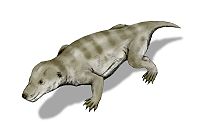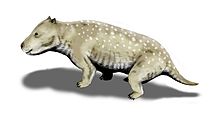- Cynodont
-
Cynodonts
Temporal range: Late Permian–present
(Descendant taxon, Mammalia survives to present).
Cynognathus Scientific classification 
Kingdom: Animalia Phylum: Chordata Class: Synapsida Order: Therapsida (unranked): Neotherapsida (unranked): Theriodontia (unranked): Eutheriodontia Suborder: Cynodontia
Owen, 1861Families See text
Cynodontia or cynodonts ("dog teeth") are a taxon of therapsids which first appeared in the Late Permian (approximately 260 Ma) and were eventually distributed throughout all seven continents by the Early Triassic (256 Ma[1]). This clade includes modern mammals and their extinct close relatives. They were one of the most diverse groups of therapsids. They are named after their dog-like teeth.
Contents
Taxonomy
Cynodontia is generally considered to be an infraorder within Therapsida.
Richard Owen named Cynodontia in 1861, which he assigned to Anomodontia as a family.[2] Robert Broom (1913) reranked Cynodonia as an infraorder, since retained by others including Colbert and Kitching (1977), Carroll (1988), Gauthier et al. (1989), and Rubidge and Cristian Sidor (2001).[3] Olson (1966) assigned Cynodontia to Theriodonta, Colbert and Kitching (1977) to Theriodontia, and Rubridge and Sidor (2001) to Eutheriodontia. William King Gregory (1910), Broom (1913), Carroll (1988), Gauthier et al. (1989), Hopson and Kitching (2001) and Botha et al. (2007) all considered Cynodontia as belonging to Therapsida. Botha et al. (2007) seems to have followed Owen (1861), but without specifying taxonomic rank.[4][5]
Evolutionary history
Together with the extinct gorgonopsians and the therocephalians, the cynodonts themselves are part of a group of therapsids called theriodonts.
The oldest and the most basal cynodont yet found is Charassognathus. Other basal cynodonts were the procynosuchids, a family that includes Procynosuchus and Dvinia. Cynodonts were among the few groups of synapsids that survived the Permian–Triassic extinction event and had a slow recovery after the extinction.
The most derived cynodonts are found within the clade Eucynodontia, which also contains the members of Mammalia. Representative genera include the large carnivorous cynognathids, equally large herbivorous traversodonts, and small and mammal-like tritylodontids and ictidosaurs. It is likely that cynodonts were at least partially if not completely warm-blooded, covered with hair, which would have insulated them and helped to maintain a high body temperature. The mammal-like structure of cynodonts hints that all mammals have descended from a single group of eucynodonts.
During their evolution, cynodonts' teeth changed from being adapted for catching and holding prey and then swallowing whole, to adding specialized teeth, including molars, designed for better mastication of food allowing for quicker digestion. Additionally, the jaw of the cynodonts reduced the number of jaw bones. This move towards a single bone for the mandible increased its structural integrity when compared to the kinetic jaws of reptiles. Several of the bones which were jaw bones in reptiles evolved in this creature to perform an entirely new function, becoming parts of the mammal's middle ear.
Improved hearing gave these creatures a better awareness of their environment and, in turn, this increasing sensitivity called for a greater capacity for processing the auditory information in the brain. Cynodonts also developed a secondary palate in the roof of the mouth. This caused air flow from the nostrils to travel to a position in the back of the mouth instead of directly through it, allowing cynodonts to chew and breathe at the same time. This characteristic is present in all mammals.
Characteristics
Cynodonts have nearly all the characteristics of mammals. Their teeth were fully differentiated, the braincase bulged at the back of the head, and many of them walked in an upright manner. Cynodonts still laid eggs, as all Mesozoic proto-mammals probably did. Their temporal fenestrae were much larger than in its ancestors, and the widening of the zygomatic arch allowed for more robust jaw musculature supporting the evidence of a more mammal-like skull. They also have the secondary palate that other primitive therapsids lacked, except the therocephalians, who were the closest relatives of cynodonts. Their dentary was the largest bone in their lower jaw, as other smaller bones moved into the ears. They were probably warm-blooded, and covered in hair.
Phylogeny
- Order Therapsida
- (unranked) Eutheriodontia
- Suborder †Therocephalia
- Suborder CYNODONTIA
- †Charassognathus
- Family †Dviniidae
- Family †Procynosuchidae
- Epicynodontia
- Family †Galesauridae
- Family †Thrinaxodontidae
- Infraorder Eucynodontia
- (unranked) †Cynognathia
- Family †Cynognathidae
- Family †Diademodontidae
- Family †Traversodontidae
- †Exaeretodon
- †Luangwa
- †Massetognathus
- †Santacruzodon
- †Scalenodon
- †Traversodon
- Family †Trirachodontidae
- Family †Tritylodontidae
- †Bienotherium
- †Bienotheroides
- †Kayentatherium
- †Oligokyphus
- †Tritylodon
- (unranked) Probainognathia
- †Ecteninion
- †Lumkuia
- Family †Chiniquodontidae
- Family †Probainognathidae
- (unranked) †Ictidosauria
- Family †Tritheledontidae
- (unranked) Mammaliaformes
- (unranked) †Cynognathia
See also
- Permian–Triassic extinction event
- Prehistoric mammal
- Tetrapod
- Triassic-Jurassic extinction event
References
- ^ PaleoBiology Database: Cynodontia, basic info
- ^ Classification of R. Owen 1861.
- ^ Classification of B. S. Rubidge and C. A. Sidor 2001
- ^ R. Broom. 1913. A revision of the reptiles of the Karroo. Annals of the South African Museum 7(6):361-366
- ^ S. H. Haughton and A. S. Brink. 1954. A bibliographical list of Reptilia from the Karroo Beds of South Africa. Palaeontologia Africana 2:1-187
- Hopson, J.A.; Kitching, J.W. (2001). "A probainognathian cynodont from South Africa and the phylogeny of non-mammalian cynodonts". Bull. Mus. Comp. Zool. 156: 5–35.
- Davis, Dwight (1961). "Origin of the Mammalian Feeding Mechanism". Am. Zoologist, 1:229-234.
External links
Kingdom: Animalia · Phylum: Chordata · Class: Synapsida · Order: Therapsida Basal therapsids Eutherapsida EutheriodontiaCynodontiaMammaliaRelated categories Synapsids · TherapsidsCategories:- Cynodonts
- Order Therapsida
Wikimedia Foundation. 2010.







